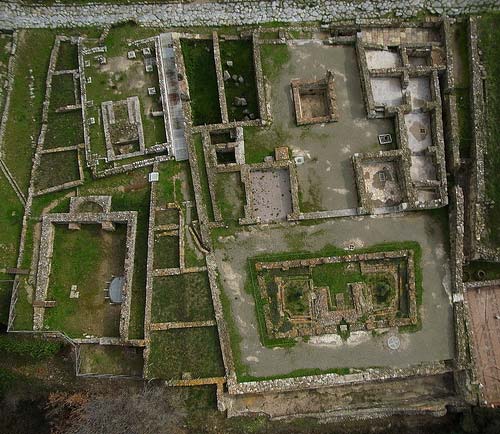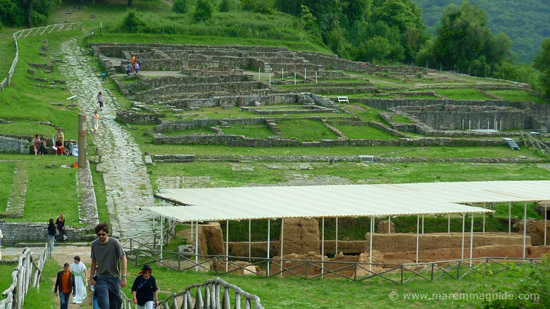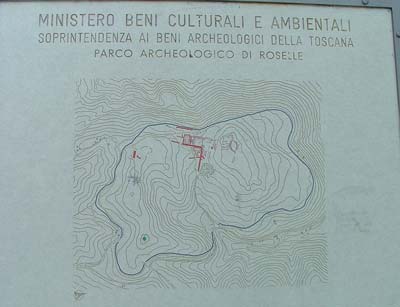Parco Archeologico di Roselle
Etruscan architecture and a Roman town in Maremma
 |
Rusallae Domus dei Mosaici in the Parco Archeologico di Roselle |
The Parco Archeologico di Roselle extends over two hills and contains the remains of the ancient city of Roselle - one of the most interesting and important archaeological areas in the whole of Italy.
Originally an Etruscan city - called "Rusellae" - situated on the shore of the ancient lake of Prile important for fishing and trade with Etruscan cities of the interior, it was invaded by Rome in 294 BC and beautified with spas, villas, and amphitheaters.
What is special about this huge site is that the sequential development of the city remains preserved as well as many of the important ancient Roman structures, such as the Forum and Basilica.
The enclosing city wall in itself is a magnificent example of Etruscan architecture, cyclopean masonry and skilled engineering over the slopes of two hills. Still standing, it is over 3 kilometres long and seven metres high and leaves you with a sense of awe.
And then there is the first century AD amphitheatre built on top of the north hill, and later Domus mosiacs...
In the sixth century Roselle was invaded by Barbary pirates and lost its primacy of power. During the Middle Ages its position declined further due to the advancement of the land at the mouth of the river Ombrone and the development of a lagoon. Unattended or drained as they had been in Etruscan times, these lands became subject to infestation and were plagued with malaria, as were the other lowlands in Maremma. Roselle was virtually abandoned until the 18th century.
The Parco Archeologico di Roselle
Opaxir Kite Aerial Photography Photo Gallery
With kind permission of Opaxir I have compiled this Photo Gallery from just a few of his fantastic kite aerial photography (KAP) shots of the area. Visit his Flickr photostream - click on the link above - for is a treasure trove of stunning birds-eye view archeological images.
Click on the photographs to view larger images
The video
If you are visiting Maremma and are at all interested in Etruscan or Roman history, this site is not to be missed. I cannot do justice to its magnificence in this one page or it would never load on your computer with all the information and photographs etc, and so I have included links at the bottom of this page to other sites where you can read and see more.

Even if you do not have time to take either of the two itinerary routes or venture into the park, I highly recommend that you make the five minutes drive up the hill to the visitor centre just to see the necropoli along the roadside on your left. The chamber tombs in this photograph and the circular tumulus necropolis below.
 |
Etruscan tombs - necropoli - alongside the road to the entrance of the Parco Archeologico di Roselle |
The information provided by the Ministero Beni Culturali e Ambientali Soprintendenza ai Beni Archeologici della Toscana at the park visitor centre reads:
 |
 |
A topological diagram and corresponding KAP aerial view of the Parco Archeologico di Roselle |
"Traces of prehistoric settlements were found in the area of Roselle but a real and true urban gathering can be defined from the 7th century BC the epoch to which is attributed the first walled city. The actual, magnificent walls encircling the 2 hills where the city developed and was contained, as well as protected, are attributed to the mid-6th century BC approx. In this period, the two hills appear populated as shown by the structures of private housing recently explored on the northern hill. The artisans' houses are on the southern hill and the residence of major importance in the central valley, where they always were and will be for centuries. Traces of the classic period are evident on the southern hill where the living quarters of artisans and others, faced the road. During this time there is evidence of basic urban organization that will be recalled by the Hellenistic city, when there is also evidence of detailed restoration of the city walls. During the 3rd century BC Roselle fought more than once against Roman conquerors. In 284 BC it submitted to Roman rule under Consul Postumius Megellus and in 89 BC the inhabitants of Roselle became Roman citizens, members of the tribe Scaptia. After a period of economic and demographic crisis, Roselle underwent a fast reconstruction - in the Forum, in the principal structures of public use and remarkable private buildings thus, the city changed image during the Augustan Age. In the late Imperial Period, Roselle's population diminished. Remains of a small round camp, maybe Lombards, dating from either the end of the 6th and the first half of the 7th century AD were found between the principal road and the commercial district with tombs in various zones of the city. When Roselle had become semi-deserted and infested with pedators. Pope Innocence II moved the Diocese to near by Grosseto in 1138." |
And the information board for the Roselle necropoli alongside the access road reads:
 |
 |
 |
Etruscan Necropoli VI-VII Century at the Parco Archeologico di Roselle |
"The archeological research of Roselle has provided an in-depth knowledge of the urban area rather than the necropolis. As modern constructions were never placed atop the antique city, this provided an unique occasion to realise methodic and planned exploration. In the necropolis, after occasional excavations in 1851 by Alessandro Francois and ten years later by the Colombaria Society, the investigation followed of the graves situated along the road leading to the excavations (the tombs can be visited). These are small chamber tombs, with short entrance corridors and roofs mase by projecting slabs: the tombs were often reused in the centuries to follow. They date between the end of the 7th and the beginning of the 6th century BC. A particular case is created by the recent finding of this tomb, with its tumulus circumscribing the grave's central cell, oriented east-west. The tumulus, found intact even if not conserved in its original elevation, consists of two walls of sandstone blocks, built with lightly weighted stones and red, local clay (diameter 12 meters). In the center of the tumulus is a rectangular cavity, holding the outer structure of a small room, whose ceiling is lost and only three walls are actually intact. No trace of an access to this tomb was found, however. The funerary objects, though in fragments, enable us to date the monument. A similar chronology could be given to a small grave for an incinerated burial, later overlaid by a road. Its funerary objects were bucchere, pets and a small lekythes with a white background." |
Recommended links for more information
For more information (in English and Italian with and photographs) about Parco Archeologico di Roselle, that of the nearby Roman complex of Podere Passerini at Bagno di Roselle and other Etruscan archeological sites in Maremma visit the excellent Parco degli Etruschi website.
Or, alternatively, the Italian Wikipedia page for "Area archeologica di Roselle", which also includes a photograph of the wonderful mosaic. Suggestion: use the Google translation service for a pretty good quality and fast translataion into English.
Parco Archeologico di Roselle Opening times
27 March to 30 October: everyday from 10:15 to 18:45. The ticket office closes at 18:00.
1 November to 26 March: everyday from 08:15 to 16:45. The ticket office closes at 16:00.
Tel: +39 0564 402403
Entrance Fees
Adults: €4.00
18-25 year old visitors: €2.00
Under 18's and over-65 year old visitors: Free
Location Map
View a larger map
Explore some more...






















